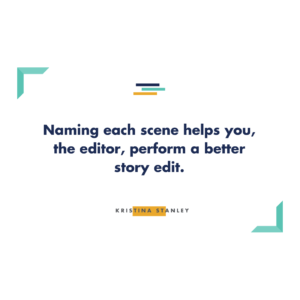
When you perform a story edit, you’ll be evaluating every scene. And to evaluate every scene, you must be able to determine what the scene is about.
Story Editing is your most comprehensive edit. It’s also called content, developmental, substantive, or structural editing. Story Editing is the primary structural review of a manuscript and the story being told.
Story Editing is your big-picture approach to preparing a writer for publishing. It’s the first structural revision. After a story edit, a writer reworks characters, plot, and settings to ensure the story line and narrative flow smoothly while every scene contributes to the story’s purpose.
Helping the Writer See
Naming each scene helps you, the editor, perform a better story edit, and it helps the writer understand how you interpreted each each.
The writer will see what you thought the scene was about. They know what they meant the scene is about, but what if they gave a different impression.
Purpose of a Scene
If the client has an issue with too many scenes that don’t appear to have a purpose, naming scenes is a good way to help them figure out the purpose of each scene. If you can’t name a scene, it may mean the scene should be broken into more than one scene because there is too much going on for one scene.
Themes
The scene name should represent the main theme or main action of the scene. It should be something you can read and immediately know what happens in the scene. If the chapter structure is not the best to move the story forward, the scene names give you insight into the theme of the chapter .
Story Outline
The goal: Name each scene using three words or fewer.
Naming the scene will create an outline you can reference as you edit. A list of scene names is also helpful when you’re evaluating the structure of the novel. You can scan the list and analyze if the scenes appear in the best order to create suspense. You’ll use the outline to see if the inciting incident, plot point 1, midpoint, plot point 2, and climax are in the right place.
Why Name a Scene
How to Name a Scene in StoryTeller
Ready to Take Your Editing to the Next Level?
A Fictionary StoryCoach helps writers tell a powerful story and makes the writer’s voice shine! You can now try Fictionary StoryCoach for editors for free for one month!
And there’s more. The Fictionary Certified StoryCoach training is available.
Do you want to become a Fictionary Certified StoryCoach? Check out Fictionary Certified StoryCoach Training.
If you’d like to take the training, send me (Kristina) an email at [email protected] telling me why you’d like to become a Fictionary Certified StoryCoach, and I’ll give you a discount.
The Fictionary StoryCoach Certification training program helps editors deliver a comprehensive and objective editorial package using StoryCoach software.
We developed this training for two reasons.
- The first is for fiction editors to have a place to learn how to perform a high-quality story edit, get certified, and then have a tool (StoryCoach) that helps them perform exceptional story edits.
- The second is for writers to know they are dealing with a professional editor who understands story when they hire a Fictionary Certified StoryCoach.
For more on story coaching check out: What is a Story Coach?

